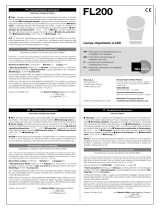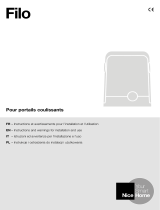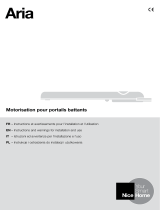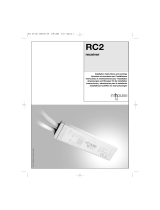Page is loading ...

English – 1
EN
WARNINGS
PRODUCT DESCRIPTION AND APPLICATIONS
— STEP 1 —
• Before proceeding with the installation, make sure the product is suit-
able for its intended use. Pay special attention to the data provided in the
“Technical Characteristics” chapter. NICE disclaims liability for any dam-
age resulting from uses of the product other than those described in this
manual.
• Protect the product’s internal components from contact with water and
other polluting substances. Keep it away from heat sources and do not
expose it to open flames. If any of these conditions occur, stop using it
immediately and call NICE customer service.
• Disconnect the power supply before proceeding with the installation opera-
tions.
• The packaging materials must be disposed of in compliance with the regu-
lations locally in force.
— STEP 2 —
The RC200 radio receiver, used in combination with the ECCO5... and
STX100 transmitters, is suitable for the remote control of single-phase equip-
ment powered by the mains voltage, with up to 500W power.
The possible commands are On/Off, “Man Present”, Timer 1 and Timer 2.
The radio receiver operates at a frequency of 433.92 MHz and can memorize
up to 30 ECCO5... and STX100 transmitters.
Instructions translated from Italian
ECCO5
STX100

2 – English
EN
INSTALLATION
— STEP 3 —
To connect the RC200 radio receiver,
the normal power cable to the equip-
ment to be controlled must be “inter-
rupted” (Fig. 1).
WARNING: Electrical systems
must be set up by qualified and
experienced personnel in compli-
ance with current legislation. As
the cable clamps do not provide
protection against pulling and the
removable cable cap can be separated, the RC200 container must be
positioned where it is inaccessible to the general public. Said con-
tainer does not guarantee protection against access to those parts
of the system which are live. If the RC200 radio receiver is installed
outdoors, keep in mind that the cable holders are waterproof only for
round cables with a diameter of 6.5 to 8.5 mm.
01. Make sure there is no voltage anywhere in the electrical circuits.
02. Cut the power cable to the equipment to be controlled.
03. Open the RC200 enclosure and remove the “cable holding cap” (Fig. 2).
04. Strip the sheath off the two ends of the cable approx. 3 cm, then strip
the single conductors approx. 5 mm.
05. Thread the two cables through the holes in the cable holding “cap”
(Fig. 3).
06. Pull the board out a few centimetres (Fig. 4).
07. Connect the conductors to the terminals (Fig. 5).
08. Fold the conductors (Fig. 6).
09. Push the board back inside the enclosure, making sure that the
stripped sections of cable are not exposed, then slide the “cap” along
the cables until the enclosure is closed tight.
10. The RC200 radio receiver does not require mounting, it can be posi-
1

English – 3
EN
tioned directly in the dedicated compartment. To avoid any risk of water
infiltrations, we recommend positioning it with the cables facing down
(Fig. 7).
WARNING: The enclosure must not be perforated for any reason.
2 3
4 5
6 7

4 – English
EN
— STEP 4 —
Power Supply
Use terminals 5-6-7 for the main power supply to the radio receiver (ground,
phase, neutral), as shown in figure alongside “Electrical Connections”.
Connection to the Equipment to Be Controlled
The equipment to be controlled (Max 500W) must be connected to terminals
1-2; No. 3 is the ground terminal.
WARNING
Terminal 7 (Neutral) is directly connected to terminal 1 of the equip-
ment to be controlled, which is therefore not com pletely isolated from
the power supply line.
Carefully follow all the connection instructions. If you have any doubts do
NOT make experiments but refer to the relevant technical specifications.
Improper connection may cause serious damage to the radio receiver.
ELECTRICAL CONNECTIONS
8

English – 5
EN
MEMORIZATION OF RADIO TRANSMITTERS
— STEP 5 —
A memorization procedure must be executed in order to enable the transmit-
ter to control the radio receiver.
WARNING:
• All the memorization sequences described in this chapter are timed, there-
fore they must be performed within the set time limits.
• All the receivers that are within the range of the transmitter can be memo-
rized via radio; it is therefore expedient to power only the radio receiver
involved in the operation.
You can check whether any transmitters have been previously memorized
in the radio receiver; this is done by counting the number of beeps emitted
when the radio receiver is switched on.
Checking the memorized transmitters
3 short beeps
Some transmitters are already memorised
2 long beeps
Empty memory (no memorized transmitters)
Two different procedures can be followed to memorize the transmitters:
– Mode 1: simplified memorization (the transmitter keys are automatically
configured by the RC200 radio receiver).
– Mode 2: advanced memorization (each single transmitter key can be con-
figured for a specific command).

6 – English
EN
Mode 1 (simplified memorization)
In this mode the functions of the transmitter keys are pre-set. The keys are
associated by pairs: keys 1 and 2 can perform the On-Off commands from
an RC200 radio receiver, whereas keys 3 and 4 can perform the On-Off com-
mands from a different RC200 radio receiver, as shown in the example below.
When the memory is empty (no memorized transmitters) you can proceed to
program the first transmitter in Mode 1 as shown in table [A].
WARNING: if you press key 1 or 2, this pair of keys will be me morized,
whereas if you press key 3 or 4, this latter pair of keys will be memorized.
Table [A] Memorizing the first transmitter
in Mode 1
Example
1 Power the radio receiver: you will hear
two long beeps
2 Within 5 seconds, press one of the keys
in the desired pair (pair 1-2 or 3-4) on the
transmitter and hold it down
5s
3 Release the key when you hear the first of
the 3 beeps confirming the memorization
If the radio receiver has already memorized one or more transmitters, when it
is switched on you will hear 3 short beeps. In this case you will not be able to
proceed as described above, but will have to switch to the memorization mode
described in Table [B]

English – 7
EN
Example of memorization in Mode 1
Key 1 On on RC200 no. 1
Key 2 Off on RC200 no. 1
Key 3 On on RC200 no. 2
Key 4 Off on RC200 no. 2
Even if one or more transmitters have already been memorized in Mode 1, ad-
ditional transmitters can be memorized in Mode 1, as described in Table [B].
Table [B] Memorizing additional transmitters
in Mode 1
Example
1 Press and hold down one of the keys in
the desired pair (1-2 or 3-4) on the new
transmitter to be memorized (New TX) until
you hear a beep (after approx. 5 seconds),
then release the key
New TX
5s
2 Slowly press one of the keys in the
desired pair on a previously memorized
transmitter (old TX)
Old TX
3 Once again, press and release the key
on the new transmitter you pressed
according to step 1
New TX
The 3 final beeps signal that the new transmitter has been correctly memorized.
If the memory is full (30 transmitters), 6 beeps will signal that the memory is not
capable of memorizing any additional transmitters.

8 – English
EN
Mode 2 (advanced memorization)
In this mode, each of the 4 available commands can be associated to a trans-
mitter key, as shown in Table [C].
Table [C] Commands available for memorization Mode 2
N° Command Description
1 On-Off The first command switches on the unit, the
next one switches it off, and so on
2 Man Present When the key is pressed the relay contact
closes. When the key is released the relay
contact opens
3 Timer 1
The contact remains closed for a length of time
ranging from 1 sec to 9 hours (programmable
as shown in Table [G])
4 Timer 2
The contact remains closed for a length of time
ranging from 1 sec to 9 hours (programmable as
shown
in Table [G])
In this mode, the memorization procedure is performed separately for each
single transmitter key; this means that 2 keys on the same transmitter can be
memorized for two commands to the same radio receiver, or to command
different receivers as illustrated in the example below:
Example of memorization in Mode 2
Key 1 On-Off on
RC200 no. 1
Key 2 Timer1 on
RC200 no. 2
Key 3 Timer2 on
RC200 no. 3
Key 4 Man Present on
RC200 no. 3

English – 9
EN
To memorize the transmitters in Mode 2, refer to Tables [D] and [E].
Table [D] Memorizing the first transmitter
in Mode 2
Example
1 As soon as the radio receiver is powered
you will hear 2 long beeps
2 Within 5 seconds, press the desired
key on the transmitter to be memorized
and hold it down until al 3 beeps have
sounded, then release the key
3 Within 3 seconds, press the same key
on the transmitter as many times as the
number corresponding to the desired
command: 1 = On-Off; 2 = Man Present;
3 = Timer1; 4 = Timer2
X1...X4
4 After approx. 3 seconds you will hear a
number of beeps corresponding to the
selected command
X1...X4
5 Within 2 seconds, press and release the
same key to confirm the programming
The 3 final beeps signal that the new transmitter has been correctly memorized.
During step 4, if you do not hear the number of beeps corresponding to the
desired function, wait 10 seconds before abandoning the procedure, then try
again.

10 – English
EN
Table [E] Memorizing additional transmitters
in Mode 2
Example
1 Press and hold down the desired key on
the new transmitter (New TX) until you
hear a beep (after approx. 5 seconds),
then release the key
New TX
5s
2 Within 5 seconds, press and hold down
for approx. 5 seconds a previously
memorized key on a transmitter (old TX)
until you hear 2 short beeps, then release
the key
Old TX
5s
3 Within 3 seconds, press again the same
key on the previously memorized tran-
smitter (old TX) as many times as the
number corresponding to the desired
command: 1 = On-Off; 2 = Man Present;
3 = Timer1; 4 = Timer2
Old TX
X1...X4
4 After approx. 3 seconds you will hear a
number of beeps corresponding to the
selected command
X1...X4
5 Within 2 seconds, press and release the
desired key on the new transmitter (new
TX) to confirm the programming
New TX
The 3 final beeps signal that the new transmitter has been correctly memorized.
If the memory is full (30 transmitters), 6 beeps will signal that the transmitter
cannot be memorized.

English – 11
EN
Memorizing a new transmitter like a previously memorized transmitter
It is possible to memorize a new transmitter so that it operates exactly like a
previously memorized one. If the old transmitter was memorized in Mode 1,
the new one will also operate in Mode 1 and a single memorization stage will
be required. If the key on the old transmitter was memorized in Mode 2, also
the key on the new transmitter will be memorized in Mode 2 and will perform
the same function. If you wish to memorize more than one key you will have
to perform a memorization procedure for each key.
Table [F] Memorizing a new transmitter
exactly like a previously memorized
transmitter
Example
1 Press the key on the new transmitter
(new TX) to be memorized and hold it
down for at least 3 seconds, then
release it
New TX
3s
2 Press the key on the previously
memorized transmitter (old TX) and hold it
down for at least 3 seconds, then
release it
Old TX
3s
3 Press the key on the new transmitter
(new TX) again and hold it down for at
least 3 seconds, then release it
New TX
3s
4 Press the key on the previously
memorized transmitter (old TX) and hold it
down for at least 3 seconds, then
release it
Old TX
3s
The 3 final beeps signal that the new transmitter has been correctly memorized.
If the memory is full (30 transmitters), 6 beeps will signal that the memory is not
capable of memorizing any additional transmitters.

12 – English
EN
Programming the Timers
The RC200 radio receiver features two independent timers (Timer1 and Tim-
er2) for automatic relay deactivation after a set time delay.
The deactivation time can be brought forward, compared to the timer setting,
by maintaining the “timer” command active for more than 3 seconds or by
giving an “Off” command.
The factory or default settings for the two timers are 1 minute (Timer1) and 10
minutes (Timer2) respectively.
The time settings can be programmed separately for each of the two timers,
from a minimum of 1 second to a maximum of 9 hours. Once the timer has
been programmed, every command associated with it will activate the relay
for the set time interval.
In order to program the timers you need to have a transmitter memorized for
timer control, then follow the steps in the table [G].
Table [G] Programming the Timers Example
1 Press and hold down the transmitter
key associated with control of the timer
you wish to program. The relay will be
activated (On)
“Relay ON”
2 Hold the key down, after approx.
3 seconds the relay will be deactivated
(Off)
3s “Relay OFF”
3 Hold down the same key for approx. 10
seconds, until the relay is activated again
(On). The time measuring stage starts at
this point. Release the key
10s “Relay ON”

English – 13
EN
4 When the time you wish to set has
elapsed, press the key associated with
control of the timer. The relay will be
deactivated (Off) and the measured time
will be memorized
“Relay OFF”
3 long beeps will signal that the time has been programmed successfully;
the following 1 or 2 short beeps indicate whether timer1 or timer2 has been
programmed.
Clearing the Receiver Memory
There may be cases when the RC200 radio receiver memory has to be cleared.
The memory can be cleared using:
– non-memorised transmitters or those which have been memorised for
“Timer” commands starting from point A.
– A previously memorized transmitter, starting from step N. 1
The following items may be erased:
– Transmitters only, proceeding up to step 4
– All the data (transmitters and timers), completing the procedure up to
step 5.
Table [H] Clearing the Memory Example
➨ A
With the radio receiver
not powered, remove
the jumper from the
board (after clearing the
memory, the jumper must
be reinstalled).
B Power the radio receiver and wait for the
initial beeps

14 – English
EN
➨ 1
• With the transmitter in
Mode 1 or
not memorized:
Press and hold down key 2 or key 4 on a
transmitter previously memorized in Mode
1 until you hear a beep (after approx. 5
seconds), then release it.
• With the transmitter in
Mode 2 (On/
Off or timer only):
For On/Off with open relay (Off), press the
key to activate it (On), release the key,
press it again and hold it down until you
hear a beep (after approx. 5 seconds),
then release the key.
For timer with open relay (Off), press the
key to activate the relay (On), hold down
the key until the relay is deactivated (Off)
and you hear a beep (after approx. 5
seconds), then release the key
5s
?... 5s
2 After 1 second, press the same key again
and release it precisely during the third
beep
3 After 1 second, press the same key again
and release it precisely during the third
beep
➨ 4
After 1 second, press the same key again
and release it precisely during the third
beep
➨ 5
If you wish to completely erase all the data
stored in the memory, press the key again
within 2 seconds and then release it
After a few seconds, 5 beeps will signal
that the memory has been cleared

English – 15
EN
— STEP 6 —
The system does not require special maintenance.
This product is made of various materials; some may be recycled and others
must be disposed of. Obtain information on product recycling or disposal, in
observance of current local standards.
Caution: come electronic components may contain pollutant
substances; never dispose of into the environment.
MAINTENANCE AND DISPOSAL

16 – English
EN
RC200 is produced by NICE S.p.A. (TV) Italy. Nice S.p.A., in order to improve
its products, reserves the right to modify their technical characteristics at
any time without prior notice. In any case, the manufacturer guarantees their
functionality and fitness for the intended purposes.
Note: all the technical characteristics refer to a temperature of 20°C.
RC200 Radio receiver
Type radio receiver for control of general
electrical equipment
Technology adopted reception and decoding of the radio
signals emitted by the transmitters
activation of the output relays only in
case of correspondence with a previ-
ously memorized code, correctly syn-
chronized with the variability sequence
Possibility of remote control with ECCO5... or STX100 transmitters
Coding 64 bit rolling code (18 billion billion
combinations)
ECCO5... and STX100 transmitters
memorization capacity
up to 30, if memorized in Mode 1
Reception frequency 433.92 MHz
Receiver sensitivity better than 0.6µV (with direct coupling)
Range of ECCO5... and STX100
transmitters
estimated at 50-100m (this distance
may vary in the presence of obstacles
or electromagnetic disturbances)
Power supply 230Vac (+10-15%) 50Hz
Maximum power output 500W / 400VA
Absorption when idle < 0.7W (typical at 230 Vac)
Activation time approx. 300ms
TECHNICAL CHARACTERISTICS

English – 17
EN
Deactivation time approx. 300ms
Maintenance of output status in
case of power failure
No
Timer resolution and precision 1s/±2%
Operating ambient temperature -10°C ... +55°C
Protection class IP55 (enclosure undamaged) with
round cables having a diameter of 6.5
to 8.5 mm
Dimensions / weight 98 x 26 x 20 / 45 g

18 – English
EN
CE Declaration of conformity
Declaration in accordance with Directive 1999/5/EC
Note: The contents of this declaration correspond to declarations in the official document deposited
at the registered offices of Nice S.p.A. and in particular to the last revision available before printing this
manual. The text herein has been re-edited for editorial purposes.
A copy of the original declaration can be requested from Nice S.p.A. (TV) Italy.
Declaration number: 584/RC Revision: 0 Language: EN
The undersigned, Roberto Griffa, in the role of Chief Executive Officer, declares
under his sole responsibility, that the product:
Manufacturer’s Name: NICE S.p.A.
Address: Via Pezza Alta 13, 31046 Rustignè di Oderzo (TV)
Italy
Model: RC200 radio receiver
Accessories:
Conforms to the essential requirements stated in article 3 of the following EC direc-
tive, for the intended use of products:
• DIRECTIVE 1999/5/EC OF THE EUROPEAN PARLIAMENT AND OF THE
COUNCIL of 9 March 1999 on radio equipment and telecommunications termi-
nal equipment and the mutual recognition of their conformity, in accordance with
the following harmonised standards:
- Health and safety (Art. 3(1)(a)): EN 62479:2010
- Electrical safety (Art. 3(1)(a)): EN 60950-1:2006+A11:2009+A12:2011+A1:20
10+A2:2013
- Electromagnetic compatibility (Art. 3(1)(b)): EN 301 489-1 V1.9.2:2011, EN
301 489-3 V1.6.1:2013
- Radio spectrum (Art. 3(2)): EN 300 220-2 V2.4.1:2012
Oderzo, 28 July 2016 Ing. Roberto Griffa
(Chief Executive Officer)
/







